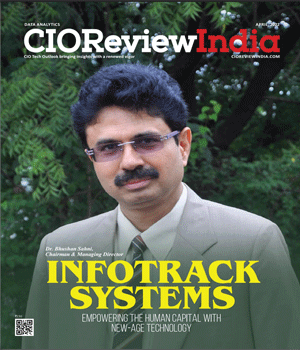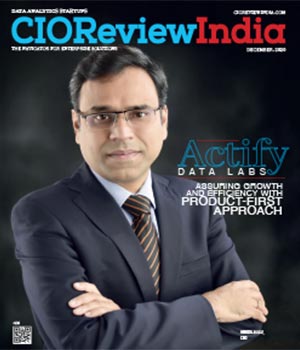
Improve Productivity In Insurance Sector By More Than 80 Percent With Robotic Process Automation
Rajesh Agarwal, SVP & Head – Robotic Process Automation, Datamatics | Monday, 23 September 2019, 05:38 IST
 The insurance industry has a very tedious and complex work environment. Right from underwriting to claim settlement, the operations include a number of processes, which are highly intertwined and time consuming. It involves vast mountains of paper work that makes each case completion almost a never ending process – a process not only extending over days but at times over weeks. Robotic Process Automation or RPA makes these processes efficient by a stunning 50 to 80 percent. It reduces mundane tasks that are tied across many legacy systems, which are entrenched in the insurance operations, albeit are outdated.
The insurance industry has a very tedious and complex work environment. Right from underwriting to claim settlement, the operations include a number of processes, which are highly intertwined and time consuming. It involves vast mountains of paper work that makes each case completion almost a never ending process – a process not only extending over days but at times over weeks. Robotic Process Automation or RPA makes these processes efficient by a stunning 50 to 80 percent. It reduces mundane tasks that are tied across many legacy systems, which are entrenched in the insurance operations, albeit are outdated.
In a predominantly legacy system based environment, RPA is revolutionizing the insurance domain. It is significantly changing the insurance operations as well as their customer service segment thereby reducing cycle times and overheads. With a CAGR of 60.5% from 2016 to 2024, RPA is the fastest growing technology. Rightly so, RPA is not only helping the knowledge workers but also the managerial cadre in the insurance companies.
“Insurance companies that focus on creating value for themselves and their customers by harnessing the disruptive technologies such as RPA, Intelligent Automation, and IoT are bound to deliver innovative products and stay ahead”
RPA bots work much like Excel macros at the field level but across multiple systems from desktop, servers, web, legacy, cloud, to Citrix. The bots work 24x7 and do the most tedious and repetitive tasks including opening applications across the aforementioned systems, copy pasting information between multiple applications, core insurance systems, unstructured email text, spread sheets, etc., validating the data between multiple websites including third party, sending email, etc. Primarily, RPA is changing the very ethos of the insurance companies and how they operate by acting as a bridge between the legacy and the new systems.
Insurance policy issuance scenario prior to RPA:
• Opening email and copying data to the core insurance systems
• Significant resource commitment especially during peak seasons
• Manual checking and validation of different product types
• Opening different systems followed by swivel chair operations between multiple systems
• Manual processes involving 100+ steps for processing each policy requiring 5 to 8 hours
• Complicated calculations using different formulae in Excel
Benefits of RPA implementation:
• Bridge the gap between multiple, disparate systems including third party to cover all swivel chair operations, without using software coding
• Automate and improve the checking and validation of insurance product types
• Automate all niche insurance processes including risk analysis, underwriting, claim settlement, new business onboarding, customer service, etc.
• Improve accuracy, efficiency, and quality of delivery as well as standardize business operations
• Facilitate faster and simplified operations, improve customer experience, reduce OpEx, and strategize growth
• Transition from paper claims processing to automated workflows within 5 months
Case-in-point:
A leading insurance company in India registered 87.5 percent increase in productivity in the process of policy document creation.
In the pre-RPA scenario, they received raw data for creating thousands of insurance policies from channel partners post their working hours on a daily basis. They had 40 different insurance products involving various nuances and different levels of intricacies. The insurance company had to deploy teams of experts to validate and standardize the data and upload it to the core Insurance system for running a policy creation batch process at 11.30 pm. It was a highly error prone and cumbersome process and required an army of resources to work late hours.
After RPA implementation, the insurance company reduced the processing time from 16 to 20 minutes to 2 to 3 minutes per case. They reduced the overall processing time from 6 hours to 1 hour. They also registered an increase in accuracy from 70-90 percent.
Future scope:
RPA is moving towards Intelligent Automation or Cognitive RPA. By using Artificial Intelligence (AI) / Machine Learning (ML), insurance companies can fast track the claim processing, reduce the time and cost required for processing, and increase customer satisfaction. They can use the intelligent algorithms to easily identify patterns and detect fraud. They can auto-evaluate damages as well as predict costs by mining historical data. Intelligent Automation is already getting implemented in pockets. Insurance companies are also harnessing the power of Internet-of-Things to ascertain usage based insurance premiums, again by utilizing user generated data. Such rapid technology advances are headed for a disruptive change in the insurance industry.
In summary
Insurance companies that focus on creating value for themselves and their customers by harnessing the disruptive technologies such as RPA, Intelligent Automation, and IoT are bound to deliver innovative products and stay ahead. These carriers will be the ones who see a sustained market growth and create new opportunities in the coming era.
CIO Viewpoint
Accept Data as an Entity on Balance sheet
By Akshey Gupta, Chief Data Officer, Bandhan Bank
Technology Forecast And Concern In 2020
By Anil Kumar Ranjan, Head IT, Macawber Beekay Private Limited
Data Analytics For Enhanced Productivity And...
By Krishnakumar Madhavan, Head IT, KLA
CXO Insights
Regulatory Implications and Data Protection:...
By Richa Singh
Data-Driven Predictive Technologies
By Pankaj Parimal, Head of Launch & Change Management, Hella Automotive Mexico, S.A. de C.V., Mexico, North America.
5 Mantras That Can Drive Organizations Towards...








.jpg)
.jpg)





